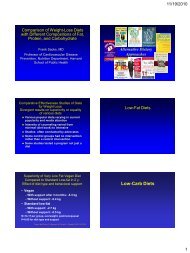Regan Bailey, Ph.D., RD - FNCE
Regan Bailey, Ph.D., RD - FNCE
Regan Bailey, Ph.D., RD - FNCE
Create successful ePaper yourself
Turn your PDF publications into a flip-book with our unique Google optimized e-Paper software.
11/18/2010<br />
Measuring Total Nutrient<br />
Intakes<br />
Purpose of NHANES<br />
<strong>Regan</strong> <strong>Bailey</strong>, <strong>Ph</strong>.D., <strong>RD</strong><br />
ADA Food and Nutrition Conference & Exposition<br />
November 7, 2010<br />
Views expressed are my own and do not reflect the views of<br />
ODS, NIH, HHS, or any other entity of the U.S. Government.<br />
To assess the health<br />
and nutritional status<br />
of adults and children<br />
in the United States.<br />
Uses of NHANES Data<br />
Eligible NHANES Population<br />
• Surveillance and monitoring<br />
• Research<br />
• Setting nutritional requirements<br />
• DRIs<br />
• Comparison with biomarkers and biological intermediates.<br />
• Public health recommendations<br />
• Prevention initiatives<br />
• Monitoring exposure levels—pollutants, chemicals<br />
• Food safety and fortification<br />
• Civilian, non-institutionalized population of the United<br />
States<br />
• Ages 2 months and older<br />
• Residents of all 50 states and DC<br />
• 5000 persons examined each year in 15 locations<br />
• Survey design determines which populations are oversampled<br />
Data Collection<br />
Household Interview<br />
1. Household interview (at home)<br />
• Questions about individual participants, their families, and<br />
their household<br />
• Dietary Supplement Information<br />
2. Mobile Exam Center (MEC)<br />
• <strong>Ph</strong>ysical exam, sensitive questions<br />
• Laboratory/biochemical information<br />
• Dietary recall<br />
Interviewers ask participants about their use of dietary<br />
supplements and also about their use of antacids.<br />
“Have you used or taken any vitamins,<br />
minerals, herbals or other dietary<br />
supplements in the past 30 days?<br />
Include prescription and non-prescription<br />
supplements.”<br />
1
11/18/2010<br />
Product Usage Questions<br />
Supplement Containers<br />
• For how long have you been taking the product or a similar<br />
type of product?<br />
• In the past 30 days, how many days did you take the<br />
product?<br />
• On the days that you took the product, how much did you<br />
usually take on a single day?<br />
If participant says that they have taken a dietary supplement,<br />
then interviewer asks to see all supplement containers.<br />
• Containers are seen 88% of the time<br />
• It is very important that containers are seen so that<br />
supplement names can be recorded accurately and<br />
completely.<br />
Dietary Supplements Flowchart<br />
Household interviews<br />
Field Office/WESTAT<br />
What Information is in the<br />
NHANES Dietary Supplement<br />
Database?<br />
Dietary Supplement data<br />
released to public NHANES Web site<br />
NCHS<br />
Reported supplement<br />
labels are found in our<br />
internal database,<br />
requested from<br />
manufacturers/distributors,<br />
or found on internet.<br />
• Supplement name<br />
• Source of information<br />
• manufacturer, distributor, and other references (such as<br />
the Internet and PDR).<br />
• Product type (infant/pediatric, prenatal, geriatric, standard)<br />
• Ingredient and dosage information<br />
• Manufacturer and Distributor information<br />
• Contact information<br />
So what do we know?<br />
Prevalence of Use of<br />
Any Dietary Supplement (%)<br />
65<br />
71<br />
39<br />
43<br />
29<br />
26<br />
39<br />
49<br />
1-3 4-8 9-13 14-18 19-30 31-50 51-70 71+<br />
Age in Years<br />
<strong>Bailey</strong> et al. Journal of Nutrition, in press.<br />
2
11/18/2010<br />
Prevalence of use<br />
of MVMM (%)<br />
44<br />
46<br />
Prevalence of Selected Vitamins and Mineral: US<br />
population ≥ 1 year (%)<br />
31<br />
29 29 29 28 27 26<br />
26<br />
32<br />
20<br />
16<br />
27<br />
35<br />
19 19 18 17<br />
1-3 4-8 9-13 14-18 19-30 31-50 51-70 71+<br />
Age in Years<br />
<strong>Bailey</strong> et al. Journal of Nutrition, in press.<br />
<strong>Bailey</strong> et al. Journal of Nutrition, in press.<br />
Users (%) of Botanical Supplements<br />
20<br />
18<br />
17<br />
13<br />
%<br />
Number of Dietary Supplements<br />
Reported in the US<br />
53<br />
2<br />
4<br />
3<br />
5<br />
20<br />
11<br />
6<br />
10<br />
1-3 4-8 9-13 14-18 19-30 31-50 51-70 71+<br />
Age in Years<br />
<strong>Bailey</strong> et al. Journal of Nutrition, in press.<br />
1 2 3 4 5 or more<br />
<strong>Bailey</strong> et al. Journal of Nutrition, in press.<br />
Supplement Use (%) by BMI<br />
Supplement Use (%) by Education<br />
56<br />
57<br />
*<br />
*<br />
37<br />
50<br />
61<br />
48<br />
< 25 25-30 ≥ 30<br />
BMI<br />
< HS HS > HS<br />
Education<br />
<strong>Bailey</strong> et al. Journal of Nutrition, in press.<br />
<strong>Bailey</strong> et al. Journal of Nutrition, in press.<br />
3
percent<br />
percent<br />
percent<br />
11/18/2010<br />
65<br />
60<br />
55<br />
50<br />
45<br />
40<br />
35<br />
30<br />
25<br />
20<br />
Adult Supplement Use by Gender<br />
male<br />
*<br />
*<br />
60<br />
female 57<br />
*<br />
47 46 47<br />
35<br />
NH3 1999-2002 2003-2006<br />
80<br />
75<br />
70<br />
65<br />
60<br />
55<br />
50<br />
45<br />
40<br />
35<br />
30<br />
25<br />
Supplement Use by Age<br />
20-39 40-59 60+<br />
70<br />
64<br />
55 55<br />
47<br />
43 42 41<br />
37<br />
NH3 1999-2002 2003-2006<br />
*<br />
Gahche et al. Unpublished Data.<br />
Gahche et al. Unpublished Data.<br />
Supplement Use Race/Ethnicity<br />
70<br />
* *<br />
60<br />
60<br />
58<br />
50 *<br />
44<br />
40<br />
33 34<br />
32<br />
29<br />
30<br />
20<br />
10<br />
NH White<br />
NH Black<br />
Mex Am<br />
36<br />
34<br />
NHANES 2003-2006<br />
• More than half the US adult population use dietary<br />
supplements (53%)<br />
• Estimated 35% of children (1 -13 years) report use of<br />
supplements<br />
• The impact of dietary supplements can not be ignored!!!<br />
0<br />
NH3 1999-2002 2003-2006<br />
Gahche et al. Unpublished Data.<br />
Total Nutrient Intake<br />
TOTAL Nutrient Intake<br />
• Food<br />
• Beverages<br />
• Fortified Foods<br />
• Dietary Supplements<br />
• Some medications (e.g. antacids)<br />
Important to evaluate total nutrient intake:<br />
• For some nutrients, portion of intake from supplements may<br />
be large (e.g., vitamin E)<br />
• Adequacy and excess perhaps underestimated if only food<br />
sources are considered<br />
• Some ULs defined only for supplement-derived nutrient<br />
intake (e.g., Mg)<br />
4
11/18/2010<br />
Total vs Usual Nutrient Intakes<br />
Usual total nutrient intake<br />
• 24-hour recall are good daily measure, but not “usual” or<br />
long-term<br />
• Usual intakes of foods and nutrients are necessary to<br />
characterize the role that nutrients play in disease<br />
prevention and treatment<br />
• Limited research exists<br />
• contribution of dietary supplements to total usual<br />
nutrient intakes among various segments of the U.S.<br />
population<br />
• Unobservable in practice<br />
• Can be estimated as the mean of multiple daily intakes<br />
• Varies from individual to individual<br />
• Distribution of usual intakes is typically of interest<br />
How do we incorporate<br />
dietary supplements in<br />
NHANES?<br />
Original Scale<br />
Transform<br />
Transformed Scale<br />
• Two days of 24-hour dietary recall - DAILY<br />
• Day 1: MEC interview<br />
• Day 2: Telephone 3 to 10 days after MEC<br />
• Dietary data are collected using USDA’s dietary data<br />
collection instrument<br />
• Automated Multiple-Pass Method<br />
• Supplement Data – MONTHLY<br />
Back transform<br />
Slide courtesy of Kevin Dodd NIH/NCI<br />
Example: Vitamin B6<br />
in Women 19-50 yrs<br />
DS: Calcium 2003-2006<br />
2,24 hr recalls &<br />
adjustments with Iowa method<br />
20% below EAR<br />
• 53% of NHANES 2003-2006 participants reported DS use<br />
• 43% used supplemental calcium<br />
• Mean = 331 mg (SE 10)<br />
• 8% (SE 0.7) met the AI through DS use alone<br />
Single 24-hour recall-<br />
37% below EAR<br />
5
Calcium (mg)<br />
mg/day<br />
11/18/2010<br />
Mean (SE) Calcium Intake by Gender<br />
and Survey Years for Calcium Users<br />
500<br />
400<br />
416.4<br />
441.7<br />
1200<br />
1000<br />
Calcium: Foods vs Total<br />
US Population: Users and Non-Users<br />
Foods<br />
Total<br />
332.6<br />
800<br />
300<br />
200<br />
188.5<br />
216.8<br />
239<br />
600<br />
400<br />
100<br />
200<br />
0<br />
NHANES III 1999-2002 2003-2006 NHANES III 1999-2002 2003-2006<br />
0<br />
1-3 4-8 9-13 14-18 19-30 31-50 51-70 71+<br />
Males<br />
Females<br />
<strong>Bailey</strong> et al. Journal of Nutrition, 2010.<br />
Percentiles of calcium intake from food alone and from all<br />
sources (total: food, dietary supplements, antacids, and drinking<br />
water) by females age 51-70 years in the United States 2003-2006<br />
4000<br />
3500<br />
3000<br />
2500<br />
2000<br />
1500<br />
1000<br />
500<br />
0<br />
Food-Alone<br />
Total Intake<br />
1 5 25 50 75 95 99<br />
Total Calcium: % above the AI<br />
100<br />
90<br />
96 97<br />
Male<br />
Female<br />
83<br />
80<br />
70<br />
67<br />
65 64<br />
60<br />
50<br />
42<br />
44<br />
38<br />
39 39<br />
40<br />
32 31<br />
30<br />
23<br />
20<br />
15<br />
13<br />
10<br />
0<br />
1-3 4-8 9-13 14-18 19-30 31-50 51-70 71+<br />
Percentiles of Intake<br />
<strong>Bailey</strong> et al. Journal of Nutrition, 2010<br />
<strong>Bailey</strong> et al. Journal of Nutrition, 2010<br />
Issues with Calcium<br />
Vitamin D<br />
Consider all sources<br />
• Water<br />
• Antacids<br />
Consider all forms<br />
• Elemental calcium in what is important<br />
• Very Few Reliable Food Sources<br />
• 37% used supplemental vitamin D<br />
• Sales increasing<br />
• Mean = 8.6 µg (SE 0.3)<br />
• Status also depends of sunlight exposure<br />
• Serum 25 (OH) vitamin D<br />
• Non-bone health<br />
6
Vitamin D (µg)<br />
11/18/2010<br />
Percent of U.S. Population using Vitamin D Supplement<br />
and Percent Meeting or Exceeding the Adequate Intake<br />
Level<br />
Mean intake for Vitamin D<br />
from Foods and from All<br />
Sources (Total)<br />
14<br />
12<br />
Foods<br />
Total<br />
10<br />
8<br />
6<br />
4<br />
2<br />
Adequate Intake levels: 14-50 years ≥ 5 mcg/day; 51-70 years ≥ 10 mcg/day; 71+ years ≥ 15 mcg/day<br />
0<br />
1-3 4-8 9-13 14-18 19-30 31-50 51-70 71+<br />
Age Group<br />
<strong>Bailey</strong> et al. Journal of Nutrition, 2010<br />
100<br />
90<br />
80<br />
70<br />
60<br />
50<br />
40<br />
30<br />
20<br />
10<br />
0<br />
Vitamin D<br />
Females: % above the AI<br />
<strong>Bailey</strong> et al. Journal of Nutrition, 2010<br />
1-3 4-8 9-13 14-18 19-30 31-50 51-70 71+<br />
Foods<br />
Total<br />
Folate 2003-2006<br />
39% of the US reported use of folic acid<br />
Folic Acid vs Folate<br />
Gender<br />
• Females > Males<br />
Race/ Ethnicity<br />
• Whites > NH Black > Mexican Americans<br />
Age Groups<br />
• 71+ = 51-70 > 31-50 > 19-30 > 14-18<br />
30<br />
“At Risk”: Below EAR<br />
Dietary Folate<br />
Total Folate (Diet + DS)<br />
FIGURE 1 Mean ({+/-}SE) percentiles of dietary and total folic acid<br />
intake in the United States, 2003-2006<br />
25<br />
20<br />
15<br />
22 22<br />
19<br />
17<br />
23 23<br />
15<br />
13<br />
24<br />
14<br />
10<br />
5<br />
0<br />
14-18 19-30 31-50 51-70 71+<br />
Females, age in y<br />
<strong>Bailey</strong>, R. L et al. Am J Clin Nutr 2010;91:231-237<br />
<strong>Bailey</strong> et al. American Journal of Clinical Nutrition, 2010<br />
Copyright ©2010 The American Society for Nutrition<br />
7
11/18/2010<br />
FIGURE 2 The cumulative distribution of usual intake of folic acid for<br />
US adults who consumed no supplements containing folic acid<br />
[n = 5277]; 0.0% exceeded the tolerable upper intake level (UL)<br />
Prevalence (percentage {+/-} SE) of folic acid intakes exceeding the Tolerable<br />
Upper Intake Level by dietary supplement use categories<br />
<strong>Bailey</strong>, R. L. et al. Am J Clin Nutr 2010;92:353-358<br />
Yang, Q. et al. Am J Clin Nutr 2010;91:64-72<br />
Copyright ©2010 The American Society for Nutrition<br />
Copyright ©2010 The American Society for Nutrition<br />
NHANES Data 2007-2008<br />
• Two days of 24-hour dietary recall<br />
• Day 1: MEC interview + DS<br />
• Day 2: Telephone 3 to 10 days after MEC + DS<br />
• 30 day frequency questionnaire<br />
• Validation<br />
• Motivations for use<br />
50<br />
45<br />
40<br />
35<br />
30<br />
25<br />
20<br />
15<br />
10<br />
5<br />
0<br />
Agreement between Methods<br />
38<br />
36<br />
46<br />
32<br />
29 28<br />
25 25<br />
23 22 23<br />
21<br />
Any Use Calcium Vitamin D Folic Acid<br />
Crombach α = 0.87<br />
Crombach α = 0.88<br />
Crombach α = 0.91<br />
Crombach α = 0.88<br />
Day 1<br />
Day 2<br />
DSQ<br />
Issues with dietary<br />
supplements<br />
Take Home Messages<br />
Moving targets<br />
• Default values<br />
No single comprehensive database<br />
• DSLD<br />
Very little known about reporting errors<br />
Analytical vs labeled labels<br />
Bioavailability<br />
Reports accepted as “truth”<br />
• Need validation<br />
• Dietary supplements may add large amounts of nutrients to<br />
dietary intake of nutrients.<br />
• Several studies indicate the users of DS actually have higher<br />
nutrient intakes and better quality diets than non-users of DS.<br />
8
11/18/2010<br />
<strong>Regan</strong> <strong>Bailey</strong>, <strong>Ph</strong>.D., R.D.<br />
baileyr@mail.nih.gov<br />
ODS Web site: http://ods.od.nih.gov<br />
• More than half the US population uses dietary supplements<br />
• Must be included in nutrient intake estimates<br />
• Must be accounted for when calculating prevalence of<br />
inadequate and excessive intakes of nutrients in a group<br />
9








